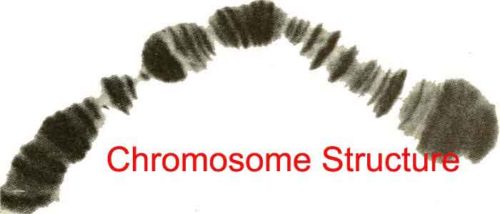The term ‘chromosome’ is consisted of two Greek words ‘Chroma’ and ‘soma’ which means color body. The chromosomes have gene bearing rod-shaped form. It is generally found in the nucleus which becomes visible during the cell division. The chromosomes also bears hereditary information.
In 1942, Karl Nagli observed the rod-like chromosome in the nucleus of plant cells and it was probably the first to report their sighting. The German scientists Schleiden first recognized the structures of chromosomes. W. Hofmeister drew the figure of the chromosome of pollen mother cells of Tradescantia. Walter Fleming (1979) introduced the term chromatin, the thread-like material of the nucleus and in 1882; he gave the accurate account of chromosome (nuclear filament). W.S. Sutton and T. Boveri (1902) suggested that the chromosomes are the bearer of heredity. DuPraw proposed the Folded Fibre Model of chromosome in 1965.
Chromosome Numbers
In a particular species, all individuals have same number of chromosomes. Chromosomes number is of great importance in the determination of phylogeny and taxonomy of the species.
Gametes (sperm and ovum) contain only one set of chromosomes. This number is called haploid number (n). The somatic or body cells usually contain two sets of chromosomes. This number is known as diploid number (2n). The haploid number of chromosome of male (n) and female (n) gametes combined and form 2n, i.e., diploid number of chromosomes. Sometime, the somatic cells of some animal as well as plant contain more than two sets of chromosomes. They are called triploids (contain three sets, 3n) and tetraploid (contain four sets, 4n), etc. The lowest haploid chromosomes number recorded in eukaryotes is two (n=2); e.g., Mesotoma ucamara (flatworm). In Ascaris megalocephalaus univalens only one pair of chromosomes are found. Belar (1926) has been observed that Aulakantha (a primitive animal) contains maximum number of chromosomes, i.e., 1600 (2n).
Chromosome number (2n) in some common plants and animals
|
Plant Species |
Chromosome number |
Animal Species |
Chromosome number |
|---|---|---|---|
|
Rye |
14 |
Common fruit fly |
8 |
|
14 |
House fly |
12 | |
|
20 |
Mosquito |
6 | |
|
Durum wheat |
28 |
Goldfish |
100-104 |
|
Bread wheat |
42 |
Toad |
22 |
|
Cultivated tobacco |
48 |
Frog |
26 |
|
Yeast |
4 |
Turtle |
32 |
|
Onion |
16 |
Pigeon |
80 |
|
Cabbage |
18 |
Cow |
60 |
|
Radish |
18 |
Dog |
78 |
|
Papaya |
18 |
Domestic cat |
38 |
|
Rice |
24 |
Domestic sheep |
54 |
|
Tomato |
24 |
Donkey |
52 |
|
Tea |
30 |
Monkey |
42 |
|
Sunflower |
34 |
Elephant |
56 |
|
Pea nut |
40 |
Chimpanzee |
48 |
|
Coffee |
44 |
Guinea pig |
64 |
|
Potato |
48 |
Guppy fish |
46 |
|
Cotton |
52 |
Horse |
64 |
|
Sugarcane |
80 |
Human |
46 |
Size and Shape of the Chromosome
The size of the chromosome varies from species to species. The length of the chromosome remains constant for a particular species and it may vary from 0.2-2 µm. The length of human chromosome is 6 µm.
The shape of the chromosome is changeable from phase to phase in the continuous process of cell growth and cell division. A chromosome contains a clear zone called Centromere or Kinetochore.
Types of Chromosomes
According to the position of centromere, the chromosome may be of the following types:
Telocentric: It is ‘I’ shaped or rod-like chromosome during anaphase stage of cell division. In this case, the centromere is situated at the terminal end of the chromosome. One arm is very long and the other is absent. This type of chromosome is very rare. Human does not possess telocentric chromosome but the standard house mouse karyotype possesses only one telocentric chromosomes.
Acrocentric: It is J or rod-shaped chromosome in which the centromere is situated near the end of the chromosome. One arm is very long and the other is very small. Five acrocentric chromosomes such as 13, 14, 15, 21, 22 are present in the human genome. The Y chromosome is also acrocentric.
Submetacentric: It is ‘L shaped chromosome in which the centromere is located slightly away from the mid-point of the chromosome. It contains a slight shorter arm than the other chromosome. In this case, the arms are unequal in length. In human submetacentric chromosomes are 4 through 12.
Metacentric: It is also ‘v’ shaped chromosome in which the centromere is situated in the middle of the chromosome. The two arms of the chromosome are nearly equal in length. Five chromosomes are considered metacentric chromosome in a normal human karyotype (1, 3, 16, 19, and 20).
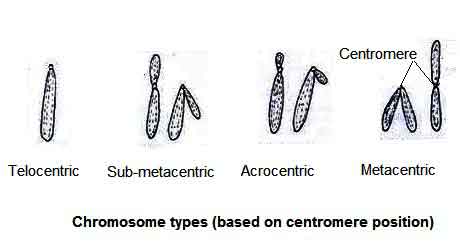
Based on the number of cetromeres, the chromosomes may be of the following types:
Monocentric: The chromosomes of most organisms contain only one centromere. This type is called monocentric chromosome.
Dicentric: When chromosome contains two centromeres then such chromosome is known as dicentric chromosome. In this case, one centromere is present in each chromatid.
Polycentric: When chromosome contains more than two centromeres then such chromosome is known as polycentric chromosome.
Acentric: Sometime a chromosome may undergo a break into two, so that only one part has the centromere while the other is without centromere. The part lacking the centromere is called acentric chromosome.
Diffused or non-located: In this case, centromere is indistinct throughout the whole length of chromosome.
Based on functions, chromosomes are of the following types:
Functionally, the eukaryotic chromosomes are classified into two types: autosomes and sex-chromosomes.
Autosomes
Most of the chromosomes in the cell are autosomes which are responsible for the determination of the body structure and functions.
Sex-chromosomes
There are one or usually two sex chromosomes which are responsible for determination of sex organ structure and their functions. The sex chromosomes are also known as accessory chromosomes, allosomes or heterochromosomes. They carry genes for determination of sex. The sex chromosomes are of two kinds, X chromosomes and Y chromosomes. These two chromosomes such as X and Y differ in size and morphology. One of the sex chromosomes has a pair of identical sex chromosomes (XX), the other may have a single sex chromosome which may be (XO) or paired with Y chromosomes (XY).
Human gametes are not identical with respect to the sex chromosomes. The male is heterogametic (XY) and produce either X or Y bearing spermatozoa in equal proportion. The female is homogametic (XX) produces only X bearing ovum. In human species (Homo sapiens), the total number of chromosome in somatic cell is 46 (23 pairs). Out of the 46 total chromosomes of man 22 pairs are autosmoes and one pair is sex chromosomes.
Structure of Chromosome
During metaphase of the cell division, the chromosomes are clearly visible under light microscope. Electron microscope studies revealed that the chromosomes are made up of the following parts:
- Pellicle
- Matrix
- Chromatid
- Chromomere
- Centromere
- Primary constriction
- Secondary constriction
- Satellite and
- Telomere, etc.
Pellicle: The thin membranous structure which remains outside the chromosome is known as pellicle.
Matrix: The semi-liquid jelly like substance present within the pellicle is known as matrix. It is supposed that during prophase, it is formed from the nucleolus and during telophase matrix reproduces nucleolus. The concept of presence of pellicle and matrix in the chromosome has been rejected by recent electron microscopic observation by Robertis (1970).
Chromatid: It is two symmetrical twisted thread-like structures containing a single DNA molecule and joined together at primary constriction. Each chromosome consists of two longitudinal subunits, the chromatids, which are in very close association with each other all along their length. This sister chromatids consists of a number of longitudinal subdivisions known as chromonemata (singular: Chromonema). According to species, the chromonema may be composed of two, four or more microfibrils. Microfibrils contain genes. The microfibrils of the chromonema remain coiled with each other which are as follows:
- Paranemic coils: The microfibrils which are loosely coiled so that they can be easily separated from each other are called paranemic coils.
- Plectonemic coils: The microfibrils remain inter-twisted so intimately that they cannot be separated easily are known as plectonemic coils.
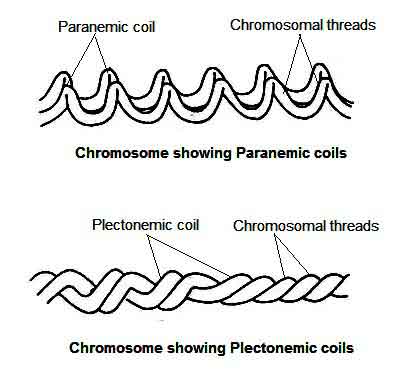
Centromere: The point of attachment of sister chromatids and side of chromosome attachment to the mitotic spindle fibre is known as centromere.
Most of the chromosomes possess usually two constrictions called primary and secondary constriction, respectively. The primary constriction is called centromere. The centromere is the structure concerned with movement of the chromosome. Without it, a chromosome cannot orient on the spindle and the chromatids cannot segregate from each other.
In eukaryotic cell, centromere plays an important role for segregating proper chromosome during mitosis and meiosis. It’s essential roles include sister chromatid adhesion and separation, chromosome movement, microtubule attachment, mitotic checkpoint control and establishment of heterochromatin.
Chromomere: The bead-like structures of the chromonema are known as chromomere. It is also known as idiomere. The chromonma of thin chromosomes of mitotic and meiotic prophase have been found to contain alternating thick and thin parts. Thus it gives an appearance of a necklace in which several beads (thick parts) are located on a string (thin parts). The beads are known as chromomeres and the string (fiber) like structure in between the chromomeres is termed as the interchromomeres.
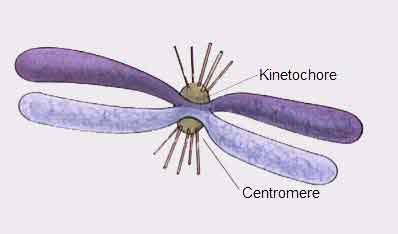
Kinetochore
- Kinetochore: The proteinaceous disc attached to the centromeric chromomares and with which spindle microtubules are attached is called kinetochore. During prometaphase and telophase, kinetochore is made up of three zones. Microtubules found embedded in all the three layers.
- Centromeric Chromomeres: During the metaphase stage of the cell division, the chromomere contains two chromatids. At this time, four granules are seen within the centromere. These granules are known as centromeric chromomeres. The granules are about 0.5 µm in size which are arranged in square.
Primary Constriction: Comparatively a lightly stained constricted region of the chromosome having its centromere which is located at a particular position is known as primary constriction. It divides the chromosomes into arms.
Secondary constriction: In addition to the primary constriction,n the arms of the chromosome may show one or more constrictions which are called secondary constriction. It may present in one or both the arms. One of the secondary constrictions is known as nucleolar organizer (secondary constriction I).
Certain secondary constriction that contains the genes for ribosomal RNAs and attaches with the nucleolus is known as nucleolar organizer. In human, nucleolar organizers are located in acrocentric chromosomes (no. 13,14,15,21, and 22). These organizers separate the small rounded piece of chromosome called satellite from the rest of the chromosome.
Satellite: The round or elongated or knob-like part present beyond the nuclear organizer of the chromosome is known as satellite. The satellite remains connected with the rest of the chromosome by a thin chromatin filament. Satellites bearing chromosomes are called SAT-chromosomes.
Tellomere: The tip of the chromosome contains the ends of long DNA a molecule that makes up each chromatid is known as telomere. It is specially modified ends of the chromosome which is used for attachment to the nuclear envelope. The ends of the chromosome are associated with the nuclear envelope from telophase to prophase.
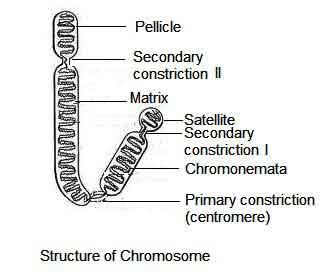
Chemical Structure of Chromosome
Chemically, chromosomes are mainly composed of nucleic acids and protein. There are trace amount of lipid, enzymes, Ca2+, Mg2+ are exist in the chromosome.
Nucleic Acid: The largest molecule of the cell is the nucleic acid. Chromosomes have There are two types of nucleic acid in chromosomes. These nucleic acids are (1) Deoxyribo Nucleic Acid or DNA and (2) Ribo Nucleic Acid or RNA
(1) Deoxyribo Nucleic Acid or DNA: It is the permanent component of chromosome. Among all components DNA contribute 45%. Actually this is a double-strand polymer of nucleotide molecules. Each nucleotide again consists of a nitrogen bases (adenine, guanine, cytosine and thymine), a deoxyribose pentose sugar and an inorganic phosphate molecule.
(2) Ribo Nucleic Acid or RNA: It is temporary component of eukaryotic chromosome but permanent genetic component of some virus. Among all components RNA contribute 0.2-1.4%. Actually it is a single-strand polymer of nucleotide molecules. Each nucleotide again consists of a nitrogen bases (adenine, guanine, cytosine and uracil), a ribose pentose sugar and an inorganic phosphate molecule.
Protein: The main structure of chromosome is made by protein. Nucleic acid remains linear arranged within protein. Two types of proteins are found in chromosome.
- Alkaline Proteins: This type of protein bears low ionic properties. Most of chromosomal alkaline proteins are of histone protein. The amount of histone protein is equal to the DNA i.e., the ratio of histone protein and DNA is 1:1 in chromosome. Another type of alkaline protein protanmine is found only in sperm.
- Acidic Proteins: These are non-histone proteins having high ionic properties. Chromosomes have several types of acidic proteins but they content more DNA polymers and RNA polymers.
Functions of Chromosomes
Chromosomes carry all necessary information to carry out different functions of the cell or incense it is the genes in the chromosomes which guide the cell in performing different functions like:
- Guiding the cell in the cell division;
- It plays an important role in inheritance of characters from generation to generation;
- Guiding protein synthesis;
- It controls all the metabolic functions of the cell;
- Self repairing;
- It plays roles in sex determination;
Roles of Chromosome in Cell Division
Chromosomes are essential for the process of cell division and responsible for the replication, division and creation of daughter cells that contain correct sequences of DNA and proteins. Proteins make up for one of the most important components of the human body.
For building muscles and tissues of the body, chromosomes play important role. In this case, the body produces thousands of enzymes, like DNA replication enzymes with the help of chromosomes which are essential for growth and repairs. Chromosome bears genes which are responsible for protein synthesis.
During cell division stages, the chromosome is responsible for the replication and distribution of DNA amongst new cells. Cell division must occur for an organism to function properly for maintaining growth, repair, or reproduction.
Reproductive cells (ovum and sperms) contain the correct number of chromosomes for building correct structure otherwise; resulting progeny may fail to develop properly. In humans, defective chromosomes made up of joined pieces of broken chromosomes cause one type of leukemia and some other cancers. During cell division, chromosomes ensure DNA is accurately copied and distributed in the vast majority of the cell division.
Chromatin and Its Types
Chromatin is the thread-like coiled elongated structure present in the nucleoplasm. It can be stained with basic stain. Emil Heitz discovered the term Heterochromatin and Euchromatin in 1928. Chromatin is mainly of two types:
- Heterochromatin and
- Euchromatin
Heterochromatin: During interphase, the regions of the chromatin of the condensed chromosome which remain tight folding and coiling and which stains deeply is known as heterochromatin. It is present in the (a) telomere (b) centromere and its both sides, (c) satellite and (d) both sides of the secondary constriction. There are two types of heterochromatins recognized (i) constitutive heterochromatin which is permanently condensed in all types of cells and (ii) facultative heterochromatin which is condensed only in certain cell types or at a special stage of development.
Euchromatin: During interphase, the portion of the chromatin which remains less tightly and which stains less deeply is known as euchromatin. The bulk of chromosome is made up of euchromatin.
Chemical composition of Eukaryotic chromatin
The chromatin of eukaryotic cell consists of four types of molecules:
- DNA,
- RNA,
- Histone (basic protein), and
- Non-histone protein.
DNA and histone combine to form nucleoprotein, a conjugated protein. They remain with the ratio 1:1. The RNA ad acid protein varies in amount quite widely from one kind of cell to another. Primarily chromosome contains 90% DNA + basic protein and 10% RNA+ acid protein. Histone is the basic protein rich in the amino acids, lysine and arginine. The chemistry of chromatin of prokaryotic cell is made up of only naked DNA.
Difference between Heterochromatin and Euchromatin
|
Heterochromatin |
Euchromatin |
|---|---|
|
It is composed of 250 Å fibres. |
It is composed of mostly 30-80 Å fibres. |
|
In heterochromatin region, the chromatin fibres are more tightly folded. |
In euchromatin region, the chromatin fibres are loosely coiled. |
|
t is seen in eukaryotic cells only. In this case, it is located at the periphery of the nucleus. |
It is seen in both eukaryotic and prokaryotic cells. In this case, it is located in the inner body of the nucleus. |
|
It stains darkly. |
It stains lightly. |
|
It contains more DNA. |
It contains less DNA. |
|
It is genetically immobile. |
It is genetically active. |
|
It does not synthesize messenger RNA(m-RNA) and protein. |
It synthesizes DNA and messenger RNA during interphase. |
|
The cross-over frequency is less. |
The cross-over frequency is more. |
|
It does not participate in transcriptional activity. |
It participates in the transcriptional activity. |
|
It shows heteropycnosis. |
It does not show heteropycnosis. |
|
It can control the structural integrity of the cell. It also regulates the gene expression. |
It creates genetic variations and enhances the genetic transcription. |
|
In this case, phenotype is not affected due to addition or loss of heterochromatin region. |
In this case, phenotype is affected due to addition or loss of euchromatin region. |
|
It is more affected by temperature, sex, age, etc. |
It is less affected by temperature, sex, age, etc. |
Giant Chromosome
At certain particular stages, some cells contain large nuclei with giant or large sized chromosomes. They are generally of two types:
- Polytene Chromosome and
- Lambrush Chromosome
Polyten Chromosome
It is also known as salivary gland chromosome. This type of chromosome first observed by Balbiani (1881) in the salivary glands of midge Chironomous and hence it is called salivary gland chromosome. Such chromosomes were observed in several other insects like Drosophila, mosquitoes, etc. As this chromosome contains many chromonema, so Koller (1888) suggested the name as polytene chromosome (poly, many).
The salivary gland chromosomes of Drosophila do not coil and the four pairs of chromosomes have total length of about 2000 µm whereas the somatic chromosome is only 7.5 µm in length. These giant polytene chromosomes display particular banding patterns. A series of dark bands alternate with clear zones called interbands. The dark bands represent regions where the DNA is more tightly coiled while in the interbands the DNA fibers are folded more loosely. There are 5000 bands in four Drosophila chromosomes. One of the most remarkable characteristics of polytene chromosome is that it is possible to visualize in them the genetic activity of specific chromosomal sites at local enlargements called puffs. The chromonema of the polytene chromosomes gives out many series of the loops laterally. These rings are known as Balbiani rings which are rich in DNA and m-RNA.
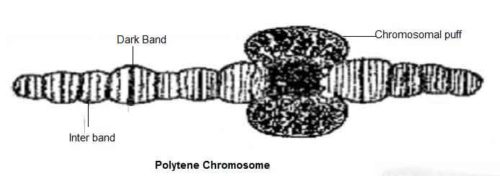
Lampbrush Chromosome
These chromosomes with highly extended lateral loops of DNA are found in animal of yolk rich oocytes (shark, amphibians, reptiles and birds) at the diplotene (diplonema) stage of meiosis. It is also found in the nucleus of Acetabularia and even in plants. The giant size of this chromosome is due to increase in size of cromonema. Lampbrish chromosomes are so named because of their many lateral loops of DNA which give them a characteristic appearance reminiscent of bottle washing brushes. It is 3 times longer (5900 µm) than polytene chromosomes. The axis of lampbrush chromosome has a row of chromomeres. Each chromomere has two lateral loops which are rich in RNA. Each loop in turn has an axis formed by single DNA molecule.
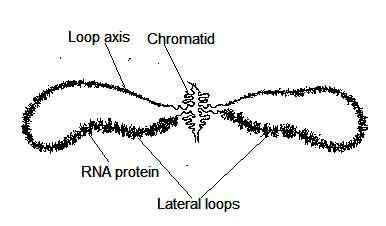
Lampbrush Chromosome

